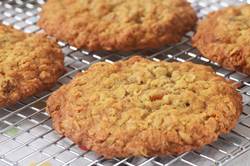|
Oatmeal
Raisin Cookies: Preheat your oven to 350 degrees F (180 degrees C). Line two baking
sheets with parchment paper, or butter or
spray them with a non stick cooking spray.
In the bowl of
your electric stand mixer, fitted with the paddle attachment (or with a hand mixer), beat the butter
and sugars until
creamy and smooth (about 2 minutes). Scrape down the sides and bottom of your bowl as
needed. Then add one egg and beat until it's mixed into the batter and then beat
in the second egg, along with the vanilla extract.
In a separate
bowl, whisk together the flour, baking soda, salt, and ground cinnamon. Add this
mixture to the batter and beat until incorporated. Stir in the rolled oats and
raisins.
For large cookies,
use 1/4 cup (60 grams) of batter (I like to use an cookie/ice cream scoop) and place
4 cookies on each baking sheet. Flatten the cookies slightly until they are about 1/2 inch (1.25
cm) thick. Bake the cookies for about 13 - 16 minutes rotating the cookie sheets
halfway through the baking time. The cookies are done when golden brown around
the edges but still a little soft in the centers. (The longer the cookies bake
the more crispy they will be.) Remove from oven and place on a wire rack. Let the cookies cool a few
minutes on the baking sheet before transferring them to a wire rack to finish
cooling. These cookies will keep several days at room temperature. They can also
be frozen.
Makes about 18 -
20 cookies.
View comments on this recipe on YouTube
|
|

Oatmeal Raisin Cookies:
1 cup (225 grams) unsalted
butter, at room temperature
1 cup (200 grams)
light brown
sugar (firmly packed)
1/3 cup (65 grams)
granulated white sugar
2 large eggs
(100 grams out of shell),
at room temperature
1 teaspoon
(4 grams) pure vanilla extract
1 1/2 cups (195 grams) all purpose
flour
1 teaspoon
(4 grams)
baking soda
1 teaspoon
(4 grams) kosher salt
1/2 teaspoon
ground
cinnamon (optional)
3 cups (260 grams)
old-fashioned rolled oats
1 cup (140 grams) dark
or golden raisins
|